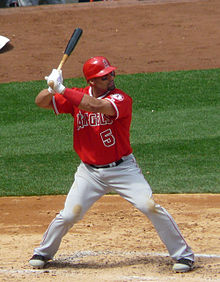Toward a general theory of Albert Pujols

Albert Pujols used to be the best player in baseball. Last year his performance was radically
sub-replacement level, which means that his team would almost certainly have been better if they had replaced him with somebody off the scrap heap of players who had been cut by their teams and could be picked up at no cost.
Here is Pujols’ adjusted OPS over the past ten seasons:
Here are his wins above replacement over the same period (note that he missed 40% of the 2013 season with injuries):
Pujols was 28 in 2008 and 37 in 2017. There are indications he will be 38 this coming season.
This might well be the most consistent age-related decline of any great player in major league history. The odds that he will bounce back to reach even replacement player value are poor; the odds that he will be good enough to justify getting another 636 plate appearances in the middle of the lineup — the number Mike Scoscia chose to give him last year, when was statistically the worst player in the majors — can be calculated as zero.
So why don’t the Los Angeles Angels of Anaheim outright release him?
I think the reasons this doesn’t seem to be happening are of some general analytic interest, even if you don’t care about Pujols or the Angels or baseball or sports. (Also I can’t blog about the political situation in this country today without risking harm to self and others).
(1) Optimism bias. If you look at the graphs above, you can talk yourself into believing easily enough that the Pujols of 2015 might somehow come back for one more season, although obviously you have to be high off your ass to think the Pujols of 2012 let alone 2009 is ever to be seen again. The 2015 Pujols was a solid regular after all, and that wasn’t so long ago was it?
(2) Confirmation bias. This is related to (1). If you’re an old time baseball fan and/or general manager, you look at Phat Albert’s 23 home runs and especially is 101 RBI last season and think, hey that’s pretty good really. Actually it isn’t: driving in 101 runs when getting 636 plate appearances in the middle of the Angels’ lineup is far from good, and it’s by far Pujols’ best raw statistic. His general ineffectiveness is reflected by his total of 53 runs scored — a shockingly bad number for an everyday cleanup hitter in an otherwise solid batting lineup. (A revealing statistic: Pujols scored 117 runs in two less plate appearances for the 2006 Cardinals, and the difference in total runs scored between that team and the 2017 Angels is almost exactly the same as the difference between Pujols’ runs scored totals in the two seasons).
In short, Pujols’ superficially not terrible triple crown stats (he hit .241, which is obviously bad, but again, 23 HRs and 101 RBI) might be sufficient to get some particularly benighted front office to sign him if the Angels were to cut him, which would at least save the Angels the major league veteran minimum portion of Pujols’ salary. Speaking of which:
(3) Sunk cost fallacy. Pujols is owed $114 million by the Angels through the next four seasons, all of which is guaranteed. Now of course it makes no sense not to cut him because of this fact, given that the team could probably replace him at literally no cost, at least for next season, assuming some other team would be willing to sign him for the veteran minimum. But the sunk cost fallacy is a powerful thing.
Anyway, the fact that the Angels seem so reluctant to cut Pujols can be rationalized: for instance he might still have some box office appeal that makes it worth keeping him, as long as the team doesn’t care that much about winning. Other rationales can no doubt he constructed, just as one can construct rationales to explain the election of Donald Trump as something other than aaaaargh.




